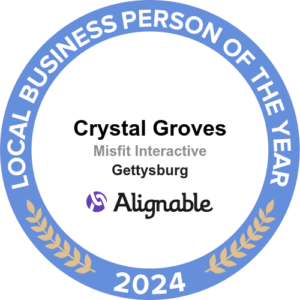Why Small Business SEO?
SEO is one of those acronyms that’s all over the online business world, and for good reason. Because although it might sound like yet another business buzzword (…acronym…whatever), it’s actually really useful.
And this is especially the case for small businesses.
As a small business owner, you want to stay ahead of the competition, keep existing customers, and reach new ones. Customers are the lifeblood of any business, and the smaller the business, the more critical that “lifeblood” is.
This is where SEO comes in (and why it’s such a big deal). You see, the potential benefits of SEO don’t end with beating your competition or ensuring a good flow of customers. Small business SEO can open up a whole new world of previously unavailable possibilities. Ever wish you could compete with the big names in your field? Or perhaps you’ve always wanted to establish yourself as a thought leader in your industry? With the right SEO, these goals can become reality.
Sounds great, right?
So what is SEO? And more importantly, what are the absolute basics of small business SEO that you need to know?
SEO in a Nutshell
As I mentioned above, SEO is an acronym. The full term is ‘Search Engine Optimization’, and it’s exactly what the term suggests. It’s the process of optimizing a website so that search engines give it first page ranking in organic search results.
This is absolutely critical. Because most people don’t venture beyond the first page of search results. So if you want your website to be seen, you need to be on that first page.
And sure, you can go ahead and pay for some ads to get on that all-important first page. After all, that’s what the big businesses do, but that can quickly become really expensive. SEO allows small businesses to get that first page privilege at a fraction of the cost.
What Does “Optimization” Look Like
You’re probably wondering what this optimization looks like and how search engines decide how to rank sites. This is something a lot SEO companies specializing in Small Business SEO claim to know. They’ll talk about it as though there are “secret sauce” solutions, formulas that only they know that will guarantee success. And to some degree there are. But they’re not exactly “secret”, and we’re far from knowing the big picture when it comes to search engine algorithms.
That’s not to say that we can’t make educated guesses though. Or try to figure out likely new algorithm changes through experimentation. We can and should do that. In fact, our knowledge of what search engines want forms the basis for our industry’s best practices.
If you’re a small business owner just looking for some SEO tips though, all of that can get pretty arcane. But don’t worry, because “what search engines want” can be boiled down into two words: user value.
You see, search engines make their money from providing searchers with the most relevant and useful sites for their inquiries. The more accurate and reliable a search engine is, the more users it has. And the more users a search engine has, the more valuable it is as a venue for paid advertisements. So basically, it’s in the interest of these big search engines to deliver sites that provide user value.
But what do we mean when we say “user value” in this context?
Adding “User Value” To Your Site
Take a few moments right now, and think about the all the business websites you’ve ever seen. Which ones stood out to you and which ones did you go back to again and again? Which ones looked trustworthy to you?
We all know what makes a good website, because they are the ones we tend to go back to ourselves. They’re the ones we don’t sigh at the thought of going to, or anticipate issues using. Most of us are pretty simple in our needs – even online. We want websites that are easy and intuitive, that run smoothly, and are fast. We want design that is pleasing to the eye, and content that is both useful and well written. And finally, we don’t want to be bothered by some autoplay media or advertisement as soon as we click on a page.
(See, you already know what “user value” looks like!)
But knowing what it looks like and translating that to your own business website can be difficult. So here are the three main areas that you should focus on, and a few tips to help get you started:
Nailing Down Your Technical SEO
As I said above, we generally want sites that are easy and intuitive, that run smoothly, and are fast. These things (along with a few others) make up what we call “technical SEO”. Technical SEO is the online equivalent of your physical store, and all the things you do to keep it attractive and comfortable for customers.

Do you find yourself wanting to hit the ‘back’ button to get off the site because it’s slow? Or perhaps you’re unsure of how to find something and/or hitting broken links? These are all signs that you need to work on your technical SEO. (They’re also a great place to get started too!)
Content Is King (Or So They Say)
If you want to give your site an SEO boost, the next area you need to focus on is content. There’s an oft-repeated saying in the online marketing world that “content is king”, and for good reason. The quality of your content forms a large part of why and how often customers and potential customers will visit your site. And with the right content – creatively applied – you can even become a thought leader in your industry.
Remember that user value I mentioned?
Content is one of the best ways in which you can add user value to your site. Your goal should be to give your customers other reasons to visit your site beyond making a purchase. Because sites that don’t offer anything other than products or services to their customers are easily forgettable. You see, the online world is filled with a slew of businesses just like your own. And many of them, can offer goods and services for far cheaper because of either size or cheaper production costs.
This is why a lot of businesses add blogs to their websites. It’s an easy way of 
Additionally, adding content through blogs can help you create a sense of connection with your customers. This is incredibly important, because online business can feel impersonal. But even though customers shop via this impersonal medium, we still want great customer service and a sense of connection. This is what forges customer loyalty. This is what really gets them returning to you again and again.
Ideally, you’ll want to consider your blog content within the context of your wider marketing strategy. You’ll also need a good mix of content too, but the majority of that content should be “evergreen”. Or in other words, always relevant regardless of when it was written. You may also want to include pieces about issues relevant to your industry written with fellow professionals in mind. Think you have a new process or way of working that’s better than the industry standard? That is your opportunity to establish yourself as a thought leader among your peers.
But whether it’s blogs, product details, or sales copy, your content needs to be coherent and well-written. There are a lot of writers on the internet nowadays, and a good many of them are excellent. People online in general are used to reading good content and websites with poorly written content rarely do well.
Don’t Forget Social Media!!
Finally, don’t miss out on the opportunity to connect with customers and potential customers on social media. (And yes, I know that social media marketing isn’t technically SEO, but I’m including it here because it’s important.) Social media can be a great place for sharing your content and driving traffic to your site. It’s also a great venue for demonstrating your customer service values in a way your customers can witness.
But that’s not all you can do with your social media. You can post videos that allow customers to see the people behind the brand. They can be serious, they can be quirky, or they can just be a glimpse into your processes. Try playing with 
You can also create and share memes and infographics on social media. These are perfect for the fast-paced social media environment. Because people don’t always have the time or space to read a blog, but most can react to a meme. Even better, you don’t have to create everything you share yourself! Social media is also a place of curated content. So don’t be afraid to share relevant content from elsewhere.
Finally, you can use social media to spark discussion among your followers and collect reviews. These are really more ways in which you can nail down that sense of connection with your customers. It can be hard to trust new (to you) companies when doing business online. We’ve all heard the stories about scams. We all know people who bought something online and who did not receive what they paid for in some way. So it’s good to keep in mind that a lot of potential customers rely on word-of-mouth and reviews. By taking a proactive approach in getting your followers talking and engaging with reviews, you can demonstrate trustworthiness. This is especially important on the local business level.
The best thing about social media marketing though (aside from it being largely free), is that you can get really creative. I’m not saying that you can’t get creative with more traditional marketing campaigns (because you can). But because of the way social media works, you can get away with a little more weirdness and levity.
Take the Denny’s Twitter account, for example. Whoever was in charge of managing that account made Denny’s go viral with off-the-wall content about pancakes! People shared the tweets, and sites like Buzzfeed created entire articles about them. Not bad for a series of tweets that included discussion of pancakes in pockets!
They were weird yet on brand, and they were a little playful – which made them great social media campaigning!
Conversely, social media can backfire pretty hard for businesses (especially if you become political). But if you keep it lighthearted, and demonstrate excellent customer service, social media is a low cost/free marketing opportunity. So go out and have fun! Go share that content, create connections, and drive that traffic to your fabulous website!
That’s All Folks?
So much for a “quick and dirty” guide to small business SEO, right?
Hopefully after reading this post though, you have a few ideas for getting your business started with SEO. Unfortunately, there’s a lot that I simply couldn’t fit in here; the topic of small business SEO is vast. Which is why a lot of small business owners come to SEO companies like us to help get them started. We offer various packages, and are quite happy to customize what we do offer to better fit your needs.
In the next post, I’m going to take a look at local small business SEO. Because local is really where it’s at for small business owners, and who doesn’t like an excellent ROI?
So be sure to check back for tips and tricks that you can use to dominate your local competition!





